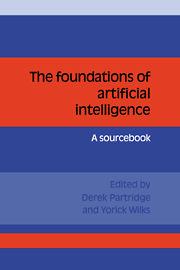Book contents
- Frontmatter
- Contents
- List of contributors
- Preface
- Acknowledgments
- 1 Introduction
- 2 The formal foundations of AI
- 3 Levels of theory
- 4 Programs and theories
- 5 The role of representations
- 6 The role of programs in AI
- 7 Rational reconstruction as an AI methodology
- 8 Is AI special in regard to its methodology?
- 9 Does connectionism provide a new paradigm for AI?
- Why there STILL has to be a language of thought
- Connectionism and the foundations of AI
- Some comments on Smolensky and Fodor
- Representation and high-speed computation in neural networks
- 10 The role of correctness in AI
- 11 Limitations on current AI technology
- 12 Annotated bibliography on the foundations of AI
- Index of names
Connectionism and the foundations of AI
Published online by Cambridge University Press: 03 May 2010
- Frontmatter
- Contents
- List of contributors
- Preface
- Acknowledgments
- 1 Introduction
- 2 The formal foundations of AI
- 3 Levels of theory
- 4 Programs and theories
- 5 The role of representations
- 6 The role of programs in AI
- 7 Rational reconstruction as an AI methodology
- 8 Is AI special in regard to its methodology?
- 9 Does connectionism provide a new paradigm for AI?
- Why there STILL has to be a language of thought
- Connectionism and the foundations of AI
- Some comments on Smolensky and Fodor
- Representation and high-speed computation in neural networks
- 10 The role of correctness in AI
- 11 Limitations on current AI technology
- 12 Annotated bibliography on the foundations of AI
- Index of names
Summary
There are few principles on which nearly all practitioners of AI will agree. One of them is that intelligence is the formal manipulations of symbols. This nearly unanimous consensus is being systematically challenged by an approach to AI that models intelligence as the passing of numerical activation values within a large network of simple parallel processors. In this connectionist approach to AI, intelligence is an emergent property of the network's processing: each individual processor has no intelligence, and the messages they exchange – real numbers – participate only in very simple numerical operations. Input to the network is coded as a set of numerical activity values on the input processors, and after this activity has propagated through the connections in the network, a pattern of activity appears on the output processors: this pattern encodes the system's output for the given input. Each connection between processing units has a numerical strength or weight, each unit typically computes its activity by using these weights to form the weighted sum of the activity of all the units giving it input, and passing this weighted sum through a non-linear response function such as a threshold or sigmoid curve.
This paper addresses the sense in which intelligence is supposed to “emerge” in these connectionist systems, and the relation that this implies between the connectionist and traditional approaches to AI. The characterization I will formulate for a connectionist approach to AI is controversial in certain respects, and is not intended as a consensus connectionist view.
- Type
- Chapter
- Information
- The Foundations of Artificial IntelligenceA Sourcebook, pp. 306 - 326Publisher: Cambridge University PressPrint publication year: 1990
- 8
- Cited by

